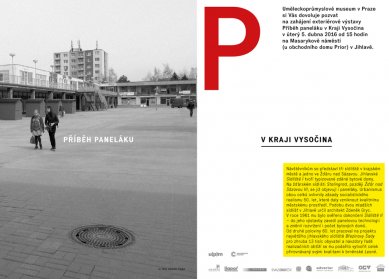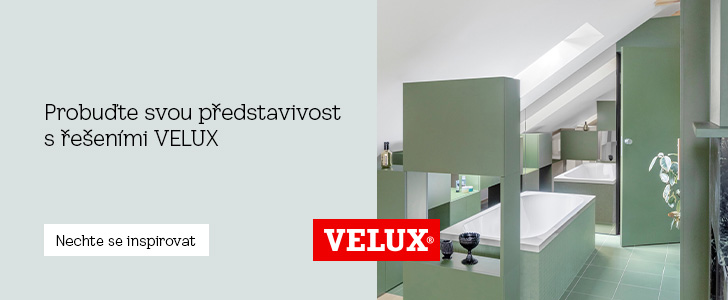
Exterior exhibition: The Story of Panel Buildings in the Vysočina Region
From April 6 to June 19, 2016, an outdoor exhibition titled The Story of the Panel House will be presented in Jihlava, showcasing the history and present of selected panel housing estates in Jihlava (Housing Estate I, Housing Estate II, Březinovy Sady) and in Žďár nad Sázavou (Stalingrad, later Žďár nad Sázavou III). This exhibition, freely accessible to the general public at Masarykovo náměstí near the Prior department store, is the eighth exhibition in a traveling series dedicated to selected panel housing estates in various regions of the Czech Republic.
“We would like to show that not all housing estates are the same, that they do not necessarily have to be monotonous clusters of boxes designed by an anonymous team in a design institute,” explains the project's main author Lucie Skřivánková (Zadražilová) from the Museum of Applied Arts in Prague. “Panel housing estates have their history, present, and in many cases, development potential, and they represent a home for their residents. Therefore, it would be a mistake to turn a blind eye to the individuality of many of them and allow ourselves to be influenced by one-sided judgments,” she adds. In the Vysočina region, 16% of the population lives in panel houses, although panel houses constitute only 2.7% of inhabited houses in the region.
The outdoor exhibition introduces visitors to three panel housing estates directly in the regional capital and one in Žďár nad Sázavou. Jihlava's Housing Estate I from the 1950s consists of standardized brick houses, and its urbanism is based partly on functionalism and partly on socialist realism, which led to the creation of a quality urban environment with clearly defined spaces and a welcoming "human" scale. The construction of brick apartment buildings and standardized family houses in Housing Estate II in Jihlava was halted at the end of the 1950s as inefficient, and new technological processes began to be tested there – for example, experimenting with cast concrete. In 1961, the completion of the estate was entrusted to architect Zdeněk Gryc, who preferred panel technology, altered the layout and number of apartment buildings, and advocated for coloring the panels in a nearby panel plant. The estate also includes an atypical shopping center. The project for Jihlava's largest housing estate, Březinovy Sady, designed for approximately thirteen thousand people, began in the second half of the 1960s, and its realization took place over the next two decades. The author Zdeněk Gryc aimed for an ideal of living in greenery but faced numerous implementation difficulties, driven in part by the increasing pressure for cost-effective construction. Nevertheless, he managed to create a whole that has been compared for its qualities to the Brno neighborhood of Lesná.
The construction of the Žďár housing estate Stalingrad, later Žďár nad Sázavou III, arose from the need to provide homes for employees of the Žďár machine works and foundry. The estate's project transformed depending on the required number of apartments, and its urbanism is based on the principles of socialist realism from the 1950s, consisting of enclosed inner blocks. Stalingrad is characterized by a varied composition of family houses and brick apartment buildings.
The realization of these housing estates often involved very capable architects who creatively developed the ideas of interwar avant-garde architects and urban planners. The exhibition addresses issues of urbanism, construction technologies, apartment layouts, and the artistic decoration of the estates. It also considers the age, educational, and professional structure of the local residents and how it has changed since the time of construction. “Using examples, we show what is happening with selected panel housing estates today, whether regeneration interventions have contributed to improving the living environment or, on the contrary, have disrupted the genius loci of these complexes,” adds Lucie Skřivánková.
Date: April 6 – June 19, 2016
Address: Masarykovo náměstí (near the Prior department store), Jihlava
Organizer of the exhibition: Museum of Applied Arts in Prague
For more information HERE and HERE
“We would like to show that not all housing estates are the same, that they do not necessarily have to be monotonous clusters of boxes designed by an anonymous team in a design institute,” explains the project's main author Lucie Skřivánková (Zadražilová) from the Museum of Applied Arts in Prague. “Panel housing estates have their history, present, and in many cases, development potential, and they represent a home for their residents. Therefore, it would be a mistake to turn a blind eye to the individuality of many of them and allow ourselves to be influenced by one-sided judgments,” she adds. In the Vysočina region, 16% of the population lives in panel houses, although panel houses constitute only 2.7% of inhabited houses in the region.
The outdoor exhibition introduces visitors to three panel housing estates directly in the regional capital and one in Žďár nad Sázavou. Jihlava's Housing Estate I from the 1950s consists of standardized brick houses, and its urbanism is based partly on functionalism and partly on socialist realism, which led to the creation of a quality urban environment with clearly defined spaces and a welcoming "human" scale. The construction of brick apartment buildings and standardized family houses in Housing Estate II in Jihlava was halted at the end of the 1950s as inefficient, and new technological processes began to be tested there – for example, experimenting with cast concrete. In 1961, the completion of the estate was entrusted to architect Zdeněk Gryc, who preferred panel technology, altered the layout and number of apartment buildings, and advocated for coloring the panels in a nearby panel plant. The estate also includes an atypical shopping center. The project for Jihlava's largest housing estate, Březinovy Sady, designed for approximately thirteen thousand people, began in the second half of the 1960s, and its realization took place over the next two decades. The author Zdeněk Gryc aimed for an ideal of living in greenery but faced numerous implementation difficulties, driven in part by the increasing pressure for cost-effective construction. Nevertheless, he managed to create a whole that has been compared for its qualities to the Brno neighborhood of Lesná.
The construction of the Žďár housing estate Stalingrad, later Žďár nad Sázavou III, arose from the need to provide homes for employees of the Žďár machine works and foundry. The estate's project transformed depending on the required number of apartments, and its urbanism is based on the principles of socialist realism from the 1950s, consisting of enclosed inner blocks. Stalingrad is characterized by a varied composition of family houses and brick apartment buildings.
The realization of these housing estates often involved very capable architects who creatively developed the ideas of interwar avant-garde architects and urban planners. The exhibition addresses issues of urbanism, construction technologies, apartment layouts, and the artistic decoration of the estates. It also considers the age, educational, and professional structure of the local residents and how it has changed since the time of construction. “Using examples, we show what is happening with selected panel housing estates today, whether regeneration interventions have contributed to improving the living environment or, on the contrary, have disrupted the genius loci of these complexes,” adds Lucie Skřivánková.
Date: April 6 – June 19, 2016
Address: Masarykovo náměstí (near the Prior department store), Jihlava
Organizer of the exhibition: Museum of Applied Arts in Prague
For more information HERE and HERE
The English translation is powered by AI tool. Switch to Czech to view the original text source.

Related articles
0
18.06.2017 | Exterior Exhibition: The Story of Panel Houses in the Liberec Region
0
14.03.2017 | Exterior exhibition: The story of panel houses in the Ústí nad Labem region
0
10.01.2017 | Exterior exhibition: The story of the panel house in the Karlovy Vary Region
0
23.11.2016 | Exterior Exhibition: The Story of the Prefabricated Building in the Plzeň Region
0
06.01.2016 | Exterior exhibition: The Story of Prefabricated Housing in the South Moravian Region
0
10.12.2015 | The Story of the Panel House: A Guided Walk with Martin Strakoš
0
11.10.2015 | Exterior exhibition: The story of prefabricated buildings in the Moravian-Silesian Region
0
24.04.2015 | Exterior exhibition: The story of the panel house in the Olomouc region
0
03.03.2015 | M.Flekačová, F.R.Václavík: The Story of the Prefabricated Building in the Pardubice Region
0
22.01.2015 | Outdoor Exhibition: The Story of the Panel House in the Pardubice Region











